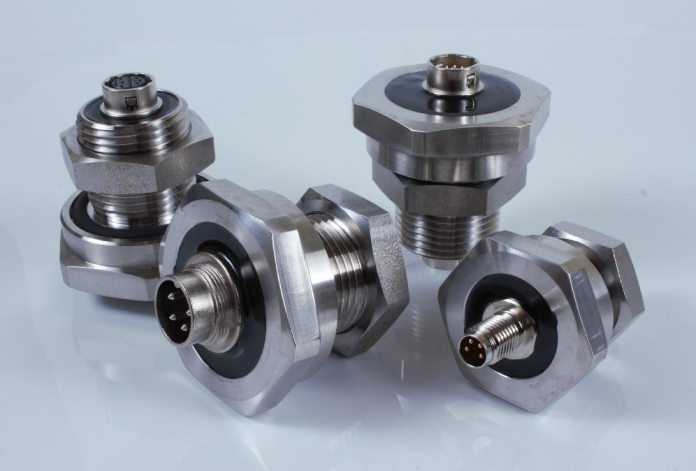Vacuum electrical feedthroughs are special devices. They let electrical signals or power into a vacuum chamber. This doesn’t harm the vacuum around it.
These critical components help equipment work in vacuum conditions. They make many industrial and scientific tasks possible.
Vacuum feedthroughs keep the vacuum environment safe. They let electrical signals pass through without breaking the vacuum.
Key Takeaways
- Vacuum electrical feedthroughs are key for keeping vacuum safe.
- They let electrical signals into a vacuum chamber.
- These devices are very important for many industrial and scientific uses.
- They help equipment work in vacuum spaces.
- Choosing the right vacuum feedthroughs is very important for best results.
The Fundamentals of Vacuum Electrical Feedthroughs
Understanding vacuum feedthroughs is key to modern tech. They let electrical power or signals into a vacuum. They keep the vacuum clean and safe.
Definition and Basic Function
Vacuum electrical feedthroughs, or hermetic feedthroughs, do two main things. They send energy and matter like liquids and gases into a vacuum. They make sure the vacuum stays clean and pure.
Historical Development of Vacuum Technology
Vacuum tech started in the 17th century. But it really grew in the 20th century. The making of vacuum electrical feedthroughs has grown with vacuum tech. It’s helped by many industries, like making semiconductors and scientific research.
Core Components and Structure
The main parts of vacuum electrical feedthroughs are a metal or ceramic body, conductors, and insulators. They are made to keep a tight seal and protect the vacuum.
| Component | Material | Function |
| Body | Metal or Ceramic | Provides structural integrity and hermetic seal |
| Electrical Conductors | Copper or Other Conductive Materials | Transmits electrical power or signals |
| Insulating Materials | Ceramic or Glass | Provides electrical insulation and maintains vacuum integrity |
How Vacuum Feedthroughs Enable Critical Technologies
In places where keeping a vacuum is key, vacuum feedthroughs help. They let electrical signals and power pass through. This is vital for tech like making semiconductors, scientific studies, and space tests.
The Vacuum-Atmosphere Barrier Challenge
Vacuum feedthroughs tackle the big challenge of the vacuum-atmosphere barrier. This barrier keeps the vacuum safe by stopping air from getting in. The feedthroughs must keep this barrier strong while letting electrical connections.

Signal and Power Transmission Requirements
Vacuum feedthroughs must send both signals and power into the vacuum. They need to keep the signal clear and stop electrical noise. Also, they must handle big voltages and currents without harming the vacuum.
Preventing Vacuum Leaks and Contamination
Stopping leaks and contamination is very important in vacuum systems. Leaks can ruin the vacuum, and contamination can damage equipment. Vacuum feedthroughs use special materials and seals to reduce these risks.
| Feature | Description | Importance |
| Vacuum Integrity | Maintaining the vacuum environment | High |
| Signal Integrity | Ensuring clear signal transmission | High |
| Power Handling | Handling high voltages and currents | Medium |
| Leak Prevention | Preventing atmospheric gases from entering | High |
Types of Vacuum Feedthroughs and Their Applications
It’s key to know the different vacuum feedthroughs for the right choice. They handle power, signals, and temperature in vacuum. Each has its own role in keeping the vacuum safe.
Power Feedthroughs
Power feedthroughs send electrical power into vacuum chambers. They’re vital for high current or voltage needs. This includes semiconductor making and vacuum coating.
Signal and Instrumentation Feedthroughs
Signal feedthroughs send low-level signals into vacuum chambers. They keep signals strong and prevent leaks. They’re used in research and analytical tools.
| Type of Feedthrough | Application | Key Characteristics |
| Power Feedthroughs | Semiconductor manufacturing, vacuum coating | High current/voltage handling |
| Signal Feedthroughs | Research applications, analytical instrumentation | Low signal loss, high precision |
| Thermocouple Feedthroughs | Temperature measurement in vacuum | Accurate temperature measurement |
Thermocouple and Temperature Sensor Feedthroughs
Thermocouple feedthroughs measure temperature in vacuum chambers. They give precise readings while keeping vacuum safe. They’re vital for temperature control.
Coaxial and RF Feedthroughs
Coaxial and RF feedthroughs send radio frequency signals into vacuum. They’re key in plasma processing and some analytical tools. Their design keeps signals strong and vacuum safe.
Materials Science Behind Vacuum Feedthrough Construction
Materials are key in making vacuum feedthroughs work well. The right materials make these parts reliable and last longer.
Metal Alloys for Vacuum Applications
Metal alloys are great for vacuum feedthroughs. They are strong, last long, and handle high temperatures well. Some alloys stay strong even when it’s very hot.
Ceramic and Glass Insulators
Ceramic and glass insulators keep vacuum feedthroughs electrically safe. They handle the tough vacuum environment well. New epoxy feedthroughs can reach very low vacuums and high temperatures.
Glass-to-Metal and Ceramic-to-Metal Seals
Sealing is vital for vacuum feedthroughs to stay sealed. Glass-to-metal and ceramic-to-metal seals are trusted for their reliability. They help keep the feedthrough leak-free and working well for a long time.
Novel Materials for Extreme Conditions
Scientists are always looking for new materials for vacuum needs. For more on vacuum feedthroughs, including materials and design, check updated guides from the manufacturers.
Key Technical Specifications of Vacuum Electrical Feedthroughs
It’s important to know the technical specs of vacuum electrical feedthroughs. These specs show how well they work in different vacuum settings. They help us choose the right ones for our needs.
Vacuum Rating Classifications
Vacuum feedthroughs have different ratings for vacuum levels. These ratings tell us how much vacuum they can handle. Here are some common ones:
- Low vacuum: Good for pressures above 1 x 10^-3 Torr.
- High vacuum: Best for pressures between 1 x 10^-3 and 1 x 10^-7 Torr.
- Ultra-high vacuum (UHV): For pressures below 1 x 10^-7 Torr, used in science and advanced tech.
Current and Voltage Handling Capacity
The current and voltage a feedthrough can handle is key. Power feedthroughs can manage high currents and voltages. They’re great for powering things in vacuum chambers.

Temperature Range and Thermal Management
Feedthroughs need to work in certain temperature ranges. Keeping them cool is important to avoid overheating. Water cooling or using materials that keep cool can help.
Leak Rate Specifications
The leak rate shows how well a feedthrough keeps vacuum tight. It’s measured in Torr-liters per second (Torr-L/s). A lower leak rate means a tighter seal, which is vital for keeping vacuum levels right.
In short, knowing the technical specs of vacuum electrical feedthroughs is key. It helps us pick the right ones for our needs.
Selection Criteria for the Right Vacuum Feedthroughs
Choosing the right vacuum feedthrough is key for many scientific and industrial uses. The right feedthrough depends on several important factors. These factors help keep the vacuum system working well.
Application-Specific Requirements
Each application needs different things from vacuum feedthroughs. For example, high-vacuum needs might call for special materials and designs. This is to cut down on outgassing and keep the system leak-free.
| Application | Key Requirements |
| High-Vacuum | Low outgassing, leak-tight design |
| High-Power | High current capacity, robust construction |
| Cryogenic | Cryogenic compatibility, low thermal conductivity |
Environmental Considerations
Things like temperature, radiation, and corrosive substances can affect vacuum feedthroughs. It’s important to think about these when picking a feedthrough.

Cost-Performance Balance
Finding a balance between cost and performance is important. High-quality feedthroughs might last longer and work better. But they can also cost more. It’s important to match the feedthrough to the application’s needs.
Compatibility with Existing Systems
It’s also key to make sure the feedthrough fits with what you already have. This means looking at things like flange size, how it connects, and what signals it can send.
By looking at these criteria carefully, you can pick the best vacuum feedthrough for your needs. This ensures your system works well and reliably.
Vacuum Feedthroughs in Scientific Research and Development
Vacuum feedthroughs are key in scientific research. They let electrical signals and power reach vacuum areas. This is vital for many scientific studies.
Particle Accelerators and Colliders
Particle accelerators and colliders need vacuum feedthroughs. They keep the vacuum while sending power and signals. These devices must be very reliable and precise.
Nuclear Fusion Research Facilities
Nuclear fusion research uses vacuum feedthroughs too. They help create the extreme conditions needed for fusion. These feedthroughs must handle very high temperatures and radiation.
Space Simulation Chambers
Space simulation chambers use vacuum feedthroughs. They mimic space conditions for testing spacecraft and satellite parts. The feedthroughs must handle the tough conditions of space.
Cryogenic Research Applications
Cryogenic research, like superconducting materials, needs special vacuum feedthroughs. These feedthroughs work at very low temperatures. They keep the vacuum while sending signals and power.
| Application | Key Requirements | Feedthrough Characteristics |
| Particle Accelerators | High reliability, precision | High-vacuum compatible, low outgassing |
| Nuclear Fusion | Extreme temperature resistance, radiation hardness | Specialised materials, robust design |
| Space Simulation | Ability to withstand harsh space conditions | Durable, resistant to extreme temperatures |
Vacuum feedthroughs are vital in science. They help send power and signals into vacuum areas. This helps advance fields like particle physics and space exploration.
Industrial Applications Relying on Vacuum Feedthroughs
Vacuum feedthroughs are key in many industries. They let electrical signals and power reach vacuum areas. They are vital for controlling vacuum conditions precisely.

Semiconductor Manufacturing Processes
In making semiconductors, vacuum feedthroughs help with etching, deposition, and ion implantation. They send power and signals to vacuum chambers. This ensures top-quality semiconductors are made.
Vacuum Coating and Thin Film Deposition
Vacuum coating and thin film deposition need vacuum feedthroughs. They control the film’s rate and check its quality. These are used for optical, decorative, and thin film electronics.
Electron Beam Welding and Additive Manufacturing
Electron beam welding and additive manufacturing use vacuum feedthroughs. They power electron guns and control systems. This allows for precise welds and parts.
Mass Spectrometry and Analytical Instruments
In mass spectrometry and analytical tools, vacuum feedthroughs are key. They send signals from vacuum detectors to outside analysis gear. This helps in accurate sample analysis and trace element detection.
Vacuum feedthroughs are vital in many industrial processes. They ensure power and signals reach vacuum areas reliably. This is essential for making high-quality products.
Installation and Integration Best Practices
Getting vacuum feedthroughs installed right is key for their best performance. A good installation means your vacuum system will last longer and work better.
Pre-Installation Preparation and Handling
Check the vacuum feedthroughs for damage or dirt before you start. Handle them carefully to avoid damage or contamination.
Mounting Techniques and Torque Specifications
Mounting them correctly is important to keep the vacuum tight. Make sure to follow the torque guide to avoid damage or leaks.
| Mounting Technique | Torque Specification | Application |
| Flange Mounting | 10 Nm | High-Vacuum Applications |
| Welded Mounting | N/A | Ultra-High-Vacuum Applications |
Testing and Verification Procedures
Do a full test after setting up to check the vacuum system’s health. This includes finding leaks and checking electrical connections.
“The integrity of the vacuum system is only as strong as its weakest link. Proper testing ensures that all components, including feedthroughs, are functioning as expected.”
Documentation and Certification Requirements
Keep detailed records of how you installed it, including feedthrough certifications. This is for traceability and to meet industry standards.
Maintenance, Troubleshooting, and Failure Analysis
Keeping vacuum feedthroughs in good shape is key. Regular checks and fixes help them work well. This keeps vacuum systems running smoothly.
Common Failure Modes and Their Causes
Vacuum feedthroughs can break for many reasons. These include damage from stress, too much electricity, and wear from harsh conditions. Knowing why they fail helps us fix them better.
- Mechanical stress from bad installation or handling
- Too much electricity from sudden spikes or surges
- Wear from very hot or corrosive environments
Preventive Maintenance Schedules
Having a plan for regular checks can stop feedthroughs from failing. We do inspections, clean them, and test them often. This catches problems early.
| Maintenance Task | Frequency | Purpose |
| Visual Inspection | Monthly | Find signs of wear or damage |
| Cleaning | Quarterly | Get rid of dirt and debris |
| Performance Testing | Bi-annually | Check if they work right |
Diagnostic Approaches and Tools
Using the right tools is key when problems happen. We use leak detection and electrical tests to find the problem.
Repair vs. Replacement Considerations
Choosing to fix or replace a feedthrough depends on several things. These include how bad the damage is, the cost, and how important it is. Sometimes, replacing it is cheaper and safer.

Standards and Regulatory Considerations for Vacuum Systems
Standards and rules are key for vacuum systems. They make sure systems are safe, work well, and fit different uses.
International Vacuum Standards
International vacuum standards guide the making and testing of vacuum gear. Bodies like the International Organization for Standardization (ISO) set these rules. They help vacuum systems meet safety and performance standards.
Industry-Specific Regulations
Each industry has its own rules for vacuum tech. For example, making semiconductors and vacuum coating need special rules. These rules help keep product quality and process reliability high.
Quality Assurance and Testing Protocols
Quality checks are vital for vacuum systems. Tests like leak rate checks and performance checks are key. They make sure systems work as they should.
Safety Considerations for High-Voltage Applications
High-voltage vacuum systems need extra safety steps. This is to avoid electrical shocks and keep users safe. Rules for high-voltage gear are very important here.
The Evolution and Future of Vacuum Technology
Vacuum technology keeps getting better, thanks to new materials and designs. Jacarem, among other professionals, shows how important electrical feedthroughs are. They let electrical signals or power go in or out of vacuum chambers.
The future of vacuum tech looks bright, with more demand for top-notch systems. This is true in fields like analytics, research, and semiconductors.
New innovations in vacuum tech are on the horizon. We’ll see better electrical feedthroughs and other key parts. As it grows, vacuum tech will open up new areas and industries, pushing it even further.









